#scott breton
Photo
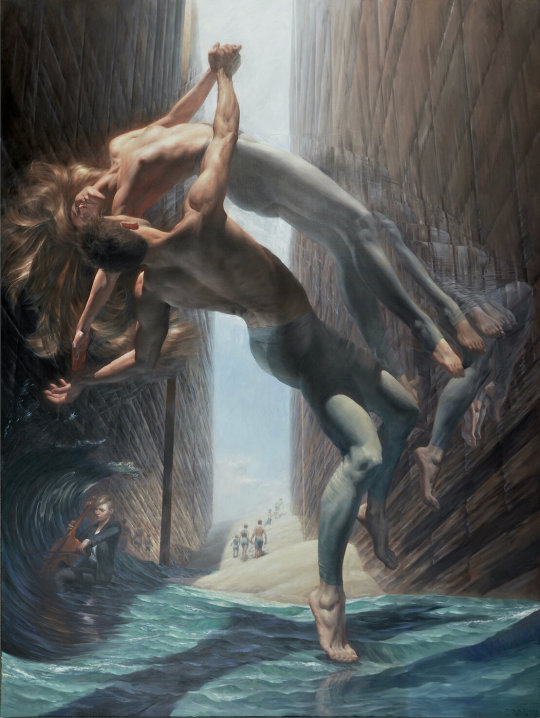
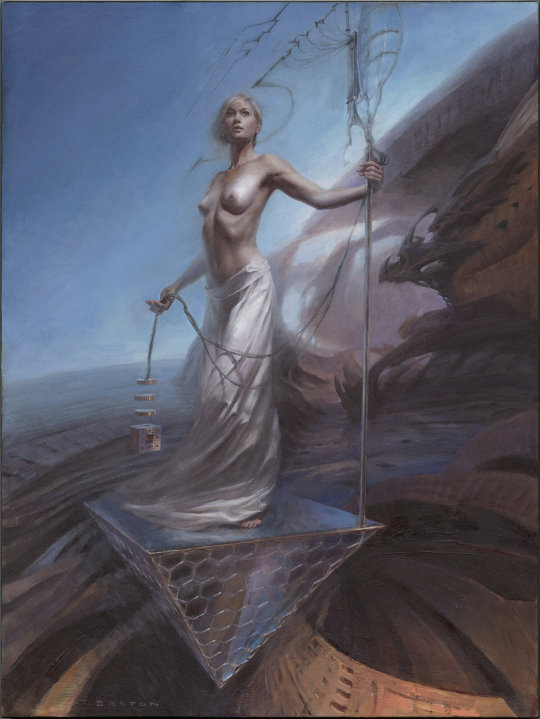


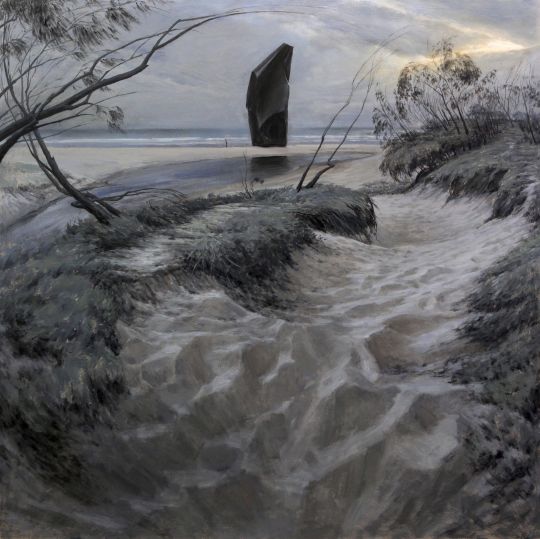
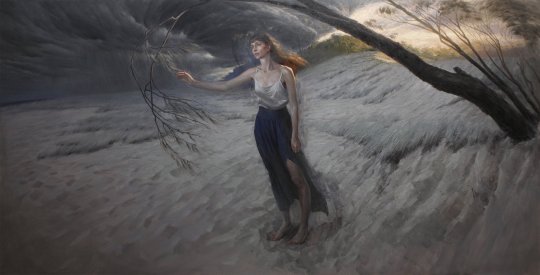

Scott Breton.
Astounding works by Brisbane, Australia-based artist Scott Breton.
Influenced by an array of subject matter, Scott’s paintings evoke futuristic dreamscapes as well as metaphorical instances of change and growth.
“Using a range of traditional drawing, painting and sculpting media as well as exploring digital counterparts to these,” Scott explains and that he “sees plastic composition rather than any particular media as the core of the classical ethos [and how its] sense of plasticity can be utilized by the contemporary artist.
“This endeavor seems to closely mirror a more general exploration of how the specifics of the contemporary human experience relate to and can be informed by insights about the human condition that have emerged across all of human history.”

BUY PRINTS | FOLLOW ON INSTAGRAM
135 notes
·
View notes
Text
Over the weekend, a story came out of Brussels that many may have missed. The twenty-seven member states of the European Union reached an agreement on a new law requiring big online platforms, including social-media companies, to police hate speech and disinformation more effectively. Under the E.U.’s Digital Services Act, European governments now have the power to ask Web platforms like Twitter, Facebook, and YouTube to remove any content that promotes terrorism, hate speech, child sexual abuse, or commercial scams. The platforms will also be obliged to prevent the “manipulation of services having an impact on democratic processes and public security.”
“The time of big online platforms behaving like they are ‘too big to care’ is coming to an end,” Thierry Breton, the E.U.’s commissioner for the internal market, declared. If the European authorities see a surge of online disinformation during a crisis, such as the ongoing war in Ukraine, they will be able to order social-media companies to take “proportionate and effective measures” to counter the threat. Although the new E.U. agreement stops short of treating online platforms the same as traditional publishers (which may be legally liable for intentionally false content about specific individuals and companies), it will force them to provide users with “an easy and effective way” to flag harmful content, so that it can be removed. The platforms will also be subject to annual audits by European regulators on their efforts to counter disinformation and other abuses. Platforms that violate the new law can be fined billions of dollars, and repeat offenders may even be banned from doing business in the E.U.
Ironically, the E.U. members adopted the new measures only days before the board of directors of Twitter entered into an agreement to sell the company to Elon Musk, a self-styled defender of free speech and a vigorous opponent of government regulation, for about forty-four billion dollars. “The proposed transaction will deliver a substantial cash premium, and we believe it is the best path forward for Twitter’s stockholders,” Bret Taylor, Twitter’s chairman, who is also the co-C.E.O. of the software company Salesforce, said in a statement.
Evidently, financial considerations overrode any reservations that the members of Twitter’s board may have had about selling the company to Musk, who has frequently criticized its management and demanded changes in how the site operates. Musk’s bid of fifty-four dollars and twenty cents a share represents a premium of close to forty per cent over the firm’s stock price on April 1st, immediately before he disclosed that he had acquired a nine-per-cent stake in the company. But, even though the financial logic of the deal is straightforward, the implications of Musk taking control of Twitter are, from a broader perspective, potentially highly problematic, especially since he still hasn’t answered some pressing questions about his intentions for the site, including whether he plans to allow Donald Trump back onto it.
In a statement on Monday, Musk said that he wanted “to make Twitter better than ever by enhancing the product with new features, making the algorithms open source to increase trust, defeating the spam bots, and authenticating all humans.” These aren’t necessarily bad ideas. Allowing users to edit tweets and authenticating their identities could conceivably improve Twitter. The idea of opening up Twitter’s algorithm also sounds benign, although it could clash with the goal of defeating the bots, because once the spammers know Twitter’s formula for serving up tweets they may be better able to game it.
But none of Musk’s suggestions addressed the fundamental issue of which approach Twitter will now take toward content moderation. Will the company maintain the heavy investments in artificial intelligence and human monitors that it has made in recent years? Will it expand these monitoring efforts as demanded by the new European law? Or will it move in the other direction, dismantling them and allowing the return of former users it had suspended or banned, particularly Trump?
Based on the signs so far, the answer to the last question is yes, Trump and others who have been banned will return. Even though Trump currently insists that he won’t return even if he is invited—he has his own social-media app to promote—many of his supporters are openly celebrating the news of Musk’s takeover. During a staff meeting on Monday, a Twitter employee asked Parag Agrawal, the firm’s chief executive, whether Trump would be allowed back. “We constantly evolve our policies,” Agrawal replied. “Once the deal closes, we don’t know what direction this company will go in.”
Based on some of his public statements, Musk seems intent on taking Twitter back to the not at all distant era when social media was a free-for-all. “I do think that we want to be just very reluctant to delete things,” he said, in an interview earlier this month. If Twitter does go in this direction, it could encounter pushback from corporate advertisers that don’t like being associated with disinformation, incitement, and controversy. Musk has suggested that Twitter should grow its subscriptions base to become less dependent on advertisers, but it’s not clear how many people would pay to use the site, especially if its contents are largely unfiltered.
Musk has also said that his pursuit of Twitter is driven by the desire to protect free speech and “help freedomn in the world” rather than to make money. These are fine-sounding words, but it sometimes seems as if Musk’s notion of free speech amounts to attacking and lampooning anybody who challenges him, including the financial regulators who charged him with securities fraud and fined him twenty million dollars for tweeting misleading information in 2018 about a possible buyout of Tesla. “Even as Twitter’s board on Monday was debating his offer . . . Mr. Musk was setting the tone for his leadership by tweeting that Securities and Exchange Commission officials were ‘shameless puppets,’ ” Greg Bensinger, a member of the Times’ editorial board, noted. Last week, Musk used his Twitter account, which has about eighty-five million followers, to try fat-shaming Bill Gates, whom he also accused of speculating against Tesla’s stock.
In a column for the Guardian, Robert Reich, a former U.S. Secretary of Labor, argued that Musk’s real goal in purchasing Twitter is to create a position for himself where he is unaccountable to anything, from laws to market competition. Whether that’s entirely accurate or not, the pending takeover provides yet another confirmation that Congress needs to treat the big online platforms like the social utilities they are, and regulate them. A first step would be to pass the American Innovation and Choice Online Act, which cleared the Senate Judiciary Committee, on a bipartisan basis, in January. This legislation would prohibit dominant platforms, such as Amazon and Google, from exploiting their market power to boost their own products by discriminating against their competitors.
Regulating content in a manner consistent with protecting free speech may be a trickier proposition, but the E.U. has just provided a road map for how it could be done: by putting the onus on social-media companies to monitor and remove harmful content, and hit them with big fines if they don’t. The Digital Services Act is “nothing short of a paradigm shift in tech regulation,” Benb Scott, the executive director of the advocacy group Reset, told the Associated Press. “It’s the first major attempt to set rules and standards for algorithmic systems in digital media markets.”
Musk would surely object to the U.S. adopting a regulatory system like the one that the Europeans are drawing up, but that’s too bad. The health of the Internet—and, most important, democracy—is too significant to leave to one man, no matter how rich he is.
#us politics#news#the new yorker#2022#elon musk#twitter#european union#Digital Services Act#Thierry Breton#Bret Taylor#Salesforce#donald trump#Parag Agrawal#tesla#the guardian#robert reich#American Innovation and Choice Online Act#senate judiciary committee#Benb Scott#Reset#associated press
124 notes
·
View notes
Video
youtube
Navigating the Snowy Abyss of Cape Breton's Slowmageddon | SaltWire #sno...
0 notes
Text

Scott Breton
16 notes
·
View notes
Photo

Ernest Pignon-Ernest
Quel crédit accorder à un artiste (un écrivain aussi bien) qui ne toucherait à aucun moment de son art au cœur même de l'humain ? Qui ne serait cet archer qui annonce à sa façon, en poète qu'il est : « Et d'un oeil avisé nous mirons droit dans la rime.» Bonheur de l'anagramme : rime, mire (rima). Le cœur de l'humain ? Métaphore du romantisme à travers les siècles, pour reprendre le titre d'un livre de Philippe Muray qui désigne en vérité, comme nous le signifie un poème du XVIII siècle, le sexe, plus précisément le sexe de la femme. Le tireur à l'arc, chasseur de fauves : « Et nous mettons droit les yeux dans la fente/Et nous ne tirons jamais de coups décochés en vain. S'il est un artiste, poète et chasseur qui sait mettre droit les yeux dans la fente du réel, de tout le réel, c'est-à-dire dans le lieu où le réel s'ouvre pour délivrer son sens; s'il est un dessinateur qui ne tire jamais un trait décoché en vain, c'est bien Ernest Pignon-Ernest.
Archée : principe de vie, feu central de la terre. Viser le feu de la femme, c’est viser dans le même temps et plus fondamentalement le feu de la terre, le principe même de la vie. Titre du tableau de Courbet : L'Origine du monde. Le Vésuve sait faire jaillir sa rougeoyante semence sur Naples et la côte amalfitaine.
Zelda, épouse de Francis Scott Fitzgerald, dans une rue de Paris, brise la vitre d'une borne d'appel aux pompiers: « Vite, vite, venez Vite, j’ai le feu au cul ! »
Naples n'est pas choisi au hasard par Ernest Pignon-Ernest. Présence de Virgile, bien sûr, près de la tombe duquel, en manière d'hommage, il colle son dessin. C'est aussi la ville où Vivant Denon situe sa Belle Napolitaine vue de dos. Vue de dos mais, robe relevée, exhibant son magnifique cul, et la tête tournée, regard aguicheur, vers les mâles suiveurs, vers nous aujourd'hui, les voyeurs du dessin, vers ceux de demain, pour s'assurer auprès de nous, auprès d'eux, d'un effet maximum. Qui m'aime me suive ! Qui me suit me baise ! Force du dessin d'Ernest : il indique que le siècle libertin de Vivant Denon est loin, que le XIX° est passé par là. La femme, de face, exhibe son sexe mais détourne la tête, se cache les yeux. La culpabilité a fait son ouvrage, du coup, son sexe est d'autant plus en feu. Double effet d'obscénité, laquelle, selon Bataille, rend la beauté du sexe encore plus fascinante : la Napolitaine n'est pas nue et elle est velue. Pas nue. Bataille encore: « Je pense comme une fille enlève sa robe. » Ernest dessine comme une fille soulève sa robe. Le dévoilement est autrement plus érotique, plus scandaleux, que le déjà dévoilé. Velue. Présence taboue de l'animalité chez la femme. Breton n'est pas Bataille, on le savait. « C'est une honte, déclarait l'auteur de L'Amour fou (retour à grands pas du XIX siècle dans la poésie du XX), qu'il y ait encore des sexes non rasés. » Merci à Virgile, merci à Pignon-Ernest, d'avoir, chacun en leur temps, fouillé, tisonné les cendres de la honte pour ranimer les laves ardentes du sexe et de l'amour.
— Jacques Henric - Femme avec le feu entre les jambes
98 notes
·
View notes
Text
ENSEMBLE
Shortlisted: All Dirt Roads Taste of Salt / Earth Mama / May December / Poor Things / War Pony
THE NOMINEES ARE:
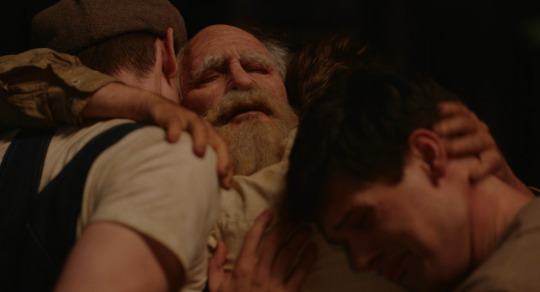
BEAU IS AFRAID
Casting by: Julie Breton and Jim Carnahan, Starring: Joaquin Phoenix, Patti LuPone, Amy Ryan, Nathan Lane, Stephen McKinley Henderson, Parker Posey, Zoe-Lister Jones, Kylie Rogers, Richard Kind, Hayley Squires, Denis Ménochet, Armen Nahapetian, Julia Antonelli

JOYLAND
Casting by: Uncredited, Starring: Ali Junejo, Rasti Farooq, Alina Khan, Sarwat Gilani, Salmaan Peerzada, Sohail Sameer, Ramiz Law, Honey Albela, Priya Usman Khan
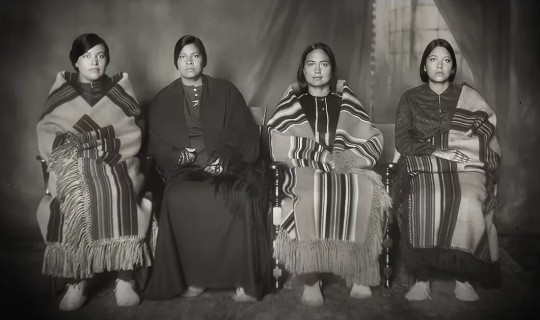
KILLERS OF THE FLOWER MOON
Casting by: Ellen Lewis, Starring: Leonardo DiCaprio, Robert DeNiro, Lily Gladstone, Jesse Plemons, Tantoo Cardinal, John Lithgow, Brendan Fraser, Cara Jade Myers, JaNae Collins, Jillian Dion, Jason Isbell, William Belleau, Louis Cancelmi, Scott Shepherd, Brent Langdon, Everett Waller, Talee Redcorn, Yancey Red Corn, Tatanka Means, Tommy Schultz, Sturgill Simpson, Ty Mitchell, Gary Basaraba, Charlie Musselwhite, Pat Healy, Steve Witting, Steve Routman, Gene Jones, Jack White, Barry Corbin, Randy Houser, Pete Yorn, Katherine Willis

TRENQUE LAUQUEN
Casting by: Uncredited, Starring: Laura Paredes, Ezequiel Pierri, Rafael Spregelburd, Elisa Carricajo, Verónica Llinás, Juliana Muras, Cecilia Rainero
AND THE CRISTAL GOES TO...

TÓTEM
Casting by: Lila Avilés and Gabriela Cartol, Starring: Naíma Sentíes, Montserrat Marañón, Marisol Gasé, Saori Gurza, Teresita Sánchez, Mateo García Elizondo, Juan Francisco Maldonado, Iazua Larios, Alberto Amador
#2023 Film Awards#Best Ensemble#Tótem#Beau is Afraid#Joyland#Killers of the Flower Moon#Trenque Lauquen
2 notes
·
View notes
Text

Julius Caesar Ibbetson (1759-1817), ‘Stone Henge 7 Miles N.W. of Salisbury’. Hand-coloured etching and aquatint on paper, from England, 1791. :: [British Museum]
* * * *
Stonehenge was carefully designed to align with the solstice, marking the extreme limits of the sun’s movements – the word solstice is derived from the Latin sol (“sun”) and sistere (“to stand still”).
The enormous sarsen stones and smaller bluestones were precisely arranged to frame two particular events in the year: the sunrise at summer solstice, and the sunset at winter solstice.
[British Museum] :: [h/t Scott Horton]
+
“When the second stage of Stonehenge was built on Salisbury Plain c. 2700 BC, it could not have been called Stonehenge, which is an English name. The English had not yet arrived. The English language had not been invented. The Plain would have been there; but it could not have been named after Salisbury, since Salisbury itself had not been founded. One may deduce that a year equivalent to 2700 BC once existed; but no such date could have been conceived before the birth of Christ or the concept of a Common Era. There was no country called 'France', and nothing equivalent to it; there was no 'England', and there was no 'Britain', and no 'Brittany'. As yet, there were no Ancient Gauls, no Ancient Britons, and no Ancient Bretons. This holds good even if each of those later communities would owe much to the gene pool of their unidentifiable predecessors.”
― Norman Davies, The Isles: A History
6 notes
·
View notes
Text
“Aisling McKeen vs Her Outdated Ideals”
—-
(Spoilers for “Scott Pilgrim Takes Off”)
Roxanne “Roxie” Richter happily hummed the Hamster Dance as she skipped through Toronto. She was on her way home from helping her friend and former member of the League of Evil Exes, Todd Ingram work out and get back on track with his vegan lifestyle. He had been making good progress.
As Roxie slid on an ice patch just outside St. Mary’s Parish, the doors opened and Roxie spotted her adorable crush, Aisling McKeen. The Cape Breton native wore a blue parka, black jeans, and Ugg boots. Her eyes were cast upward as her mouth moved.
Roxie smiled warmly. She’d had a crush on Aisling since they bumped into each other completely by chance a few weeks back.
The problem was that Aisling still hadn’t accepted that she liked girls. Something was holding her back.
And it was Roxie’s self-appointed mission to help her over that hurdle. Then go out with Aisling.
Roxie used a smoke bomb to vanish, then reappeared in front of her crush. “Hey, Ash.”
Aisling smiled. “Good morning, Roxie. How are you today?”
“A little hungry, actually. I know this amazing cafe that has really good French Toast. Care to join me?” Roxie requested.
Aisling considered the offer. “You mean… as friends, right?”
“With benefits?” Roxie asked eagerly.
“No benefits,” Aisling gestured toward the Church. “Sacreligious.”
Roxie deflated. “Worth a shot. But, yes, just a friendly brunch. I… recently went through a hell of a battle and could use some normalcy to ground myself.”
Aisling giggled. “How normal can our lives be when you have ninja powers and I’m a Cleric?”
Roxie shrugged. “Nothing tries to kill us today?”
“Fair.” Aisling replied.
—
At the small cafe, the two young women sat across from each other. “So, why did you leave Cape Breton?” Roxie asked.
Aisling sighed. “Partially because I wanted to travel and see where my talents would be most needed, but mostly because… I wanted to distract myself from my past. See, Cape Breton is small. Everyone knows everyone. They know you. All your business. And when someone caught me staring at a fellow female Cleric with… more than just curiosity, it got back to my father… the Chief Cleric…”
Roxie frowned. “And… how did he take it?”
“I don’t know. I left before he could summon me.” Aisling admitted.
Roxie winced. “Oof… sorry, Ash,” she reached across the table and took Aisling’s hand. “Is that why you’re… trying to deny that part of yourself?”
Aisling pulled her hand away. “It’s not me. It was… Satan’s influence. It had to be. It’s not… natural to be attracted to the same sex.”
Roxie sighed. It was worse than she thought. She looked at Aisling with pity. “Honey… don’t Catholics believe that God makes each of us the way we’re meant to be?”
“Well, yes, but…” Aisling trailed off.
“Look, God made you gay. And He didn’t do it to punish you. He did it for a reason. A good reason,” Roxie reached for Aisling’s hand again. “If people tell you that’s wrong, they’re the problem, not you. It’s okay to like girls, Ash.”
“But… if I’m in a relationship with a girl, I can’t… get married according to Catholic rite… or have children.” Aisling countered.
Roxie laughed. “Whoa, slow down, girl. You’re not dating anyone yet. Don’t worry about that stuff. Live in the now.”
Aisling glared at her. “You’re not even Catholic. How can you know God’s will? His plan for me?”
“Because, religious or not, having trouble with coming out is fairly common. Sure, some have it easier than others, but sometimes, coming out can be a real nightmare. And the possibility of that nightmare becoming reality is what can stop us in our tracks,” Roxie smiled and squeezed Aisling’s hand. “That’s why you need to surround yourself with people who will love you for you.”
Aisling looked away. “But if you’re wrong… and God doesn't want me to like girls… I’ll lose my powers.”
“No, you won’t.” Roxie declared.
“How do you know?” Aisling demanded.
“Because you still have them despite the way you looked at that Cleric. Despite the way you blushed when we first met,” Roxie leaned in close. “You’re gay and I like that about you.” She kissed Aisling. It was a quick kiss, no passion.
But from the moment Roxie’s lips touched hers, an electric spark raced from Aisling’s lips down to her heart. She suddenly felt a surge of power race through her.
Thou hast discovered thy true self, Daughter. Your magics are now +5 Healing, +4 Accuracy, +5 Mana. Use them well for my Glory.
When the kiss parted, Roxie smiled. “So? Did you see sparks too?”
Aisling blinked. “Uh-huh… and I think… I’m a stronger Cleric for it too.”
“Cool,” Roxie sat back, resting a hand on her cheek. “So, what now?”
“Well, we eat French Toast… ooh, with blueberries… then… I dunno, maybe I call my folks and tell them I’m okay,” Aisling smiled warmly. “That I’m loved.”
“Solid plan.” Roxie smiled back.
5 notes
·
View notes
Text
Groups of writers, artists, and thinkers who share common interests, ideas, and values, and who come together to discuss and promote their work.
These groups often emerge during periods of cultural and social change and are characterized by their innovative and unconventional approach to art and ideas.
The Algonquin Round Table was a group of witty writers and critics who gathered for lunch at the Algonquin Hotel in New York City. They were known for their sharp wit, humor, and wordplay. The members included Dorothy Parker, Alexander Woollcott, and George S. Kaufman.
"Gertrude Stein's salon" or simply the "Stein salon" was a gathering place for writers, artists, and intellectuals in Paris during the early 20th century. Stein and her partner, Alice B. Toklas, hosted weekly gatherings in their apartment which became a center for avant-garde culture and a meeting place for artists such as Pablo Picasso, Henri Matisse, and Georges Braque, as well as writers such as Ernest Hemingway, F. Scott Fitzgerald, and T.S. Eliot.
The Bloomsbury Group - a group of writers, artists, and intellectuals who lived in the Bloomsbury area of London in the early 20th century. Members included Virginia Woolf, E.M. Forster, and John Maynard Keynes.
The Harlem Renaissance - a cultural movement that emerged in Harlem, New York City, in the 1920s and 1930s. It was characterized by a flowering of African American art, literature, and music, and included artists such as Langston Hughes, Zora Neale Hurston, and Duke Ellington.
The Surrealists - a group of artists and writers who were associated with the Surrealist movement, which began in France in the 1920s. Members included Salvador Dali, Andre Breton, and Max Ernst.
The Inklings - a literary discussion group associated with Oxford University in the 1930s and 1940s. Members included J.R.R. Tolkien, C.S. Lewis, and Charles Williams.
The Black Mountain poets - a group of poets associated with Black Mountain College in North Carolina in the 1940s and 1950s. Members included Robert Creeley, Charles Olson, and Denise Levertov.
The Beat Generation - a group of writers and poets who emerged in the United States in the 1950s. Members included Jack Kerouac, Allen Ginsberg, and William S. Burroughs.
The Factory was Andy Warhol's studio and creative hub in New York City during the 1960s and 1970s. A gathering place for a diverse group of artists, musicians, and other creatives. Notable figures associated with the Factory include musicians Debbie Harry and Lou Reed, artists like Jean-Michel Basquiat and Keith Haring, photographer Robert Mapplethorpe, and author Truman Capote.
6 notes
·
View notes
Note
yo pls drop the names of those bretons + pre-roman peoples in iberia books..
João Aguiar is the man for pre Roman stories. Uma Deusa na Bruma is my favourite book of his, A Voz dos Deuses and A Hora de Sertório are equally good. They are all about the roman invasion of the iberian peninsula or just roman presence. The second one I mentioned is about Viriato. I call Uma Deusa na Bruma the portuguese mists of Avalon, and what's so fucking great about that book, is that at the very end he has an afternote where he explains the creativity process behind the book from the moment he assisted in excavations in the north of portugal. It's so goddamn interesting
Marion Zimmer Bradley is your go to for bretons and shit, especially arthuriana and welsh/breton myths. It's not just the Mists of Avalon. The Forest House is one of the most beautiful books I've ever read but keep in mind it's love story, that's all it is. You also have The Lady of Avalon and another one I forget the name rn tbh. For even older shit check The Fall of Atlantis. The Firebrand is the Trojan war seen through Cassandra's eyes.
Just a warning about MZB. Number one, expect a rape scene to show up. For one reason or another, there's always one. Number 2, outside the Mists of Avalon, sex scenes are pretty cringe. The Mists of Avalon actually describes sex very beautifully but homegirl gave it all in those 4 books and then just gave up. Number 3, stay away from The Crows of Avalon, it was not written by her, it was written by her half sister and it fucking sucks. And most importantly, bc I feel it's my moral duty to warn you of this:
MZB is a monumental piece of shit. Like, she was an absolutely horrific woman. You wanna enjoy the books, stay away from the woman herself. Don't think too hard on the 80s new age feminism people branded her work with. Her books can be painfully problematic, cringe as fuck and awkward, but many of them are beautiful stories. It's just that as a human being, she was a pile of shit.
Also check Manda Scott's Boudica saga. It's insanely good and oh my god does that woman know her horses
If you like that kind of shit, give Juliet Marillier a try. Juliet Marillier is the "graduated from The Mists of Avalon" saga, but I sincerely hated the first book with a burning passion. Daughter of the Forest, I think it's called. It's inspired by a german fairy tale (better known as the irish tale of the Children of Lir) and it's set in Ireland around the 4th century I believe. Again, I hated it but that was me, you might like it
That's all I can remember for now, I'll get back to this post if something occurs to me in the meantime
9 notes
·
View notes
Photo

Breton Nude
William Scott (1913–1989)
Bristol Museum & Art Gallery
3 notes
·
View notes
Text
“[....]Sigmund Freud suggested that the return of the dead constitutes the most primal and profound fear of humanity. “There is,” he wrote in 1919, “scarcely any other matter upon which our thoughts and feelings have changed so little since the very earliest times . . . the belief that the dead man becomes the enemy of his survivor and seeks to carry him off.”
* * *
[....]The work of the avant-garde had, by 1920, bridged the trauma of war and the world of the horror film. André Breton, who wrote the Surrealist Manifesto (1924), had his life profoundly altered by his own experience of the Great War. Born into a petit bourgeois family in Normandy, Breton studied medicine and psychiatry before 1914 and then served in a neurological medical unit in Nantes in 1915. Here he witnessed firsthand the effects of war trauma, the shell shock of soldiers from the front, most soon forced to return or face the accusation of malingering.
While working at the hospital in Nantes, Breton befriended a fellow devotee of experimental literature, Jacques Vaché. The antisocial, monocle-wearing Vaché has been nearly forgotten today. However, his Lettres de guerre (War Letters), published in 1919, heavily influenced Breton and the surrealist movement more generally, with his description of the trenches as a monstrous compendium of blood and bodily fluids, rain “pissing like vinegar” and the sun “sprinkled with acid” when it looks on the cataclysm below. Vaché committed suicide by overdosing on opium soon after the war.
Horror offered the surrealists the grammar for the new language they sought to create. The form offered a way to represent shell shock in both its literal and metaphoric manifestations. Surrealists developed a deep fascination with the work of Freud, whose essays on the nature of trauma and nightmare began to appear in the 1910s. Freud’s three sons, Martin, Oliver, and Ernst, all served in the Austro-Hungarian army. Martin spent much of 1915–1918 in an Italian prisoner of war camp. Observation of the global bloodletting forced Freud to broaden his definition of trauma beyond infantile sexuality and early, repressed memories of Oedipal obsessions. A death instinct—which included both horror and allure—lay submerged and waiting in our swamplike unconscious, a greater threat than our sexual repressions.
Surrealist art, heavily influenced by Freud, in turn influenced the first horror films. The earliest masterpieces of horror, including Nosferatu, The Golem, and The Cabinet of Dr. Caligari (1920), all drew on surrealist themes. Carl Theodor Dreyer’s haunting Vampyr (1932) self-consciously sought to put surrealism and other modern artistic movements onto film stock. Dreyer commented on his passionate interest in modern art at the time of making Vampyr. The monster masterpieces from Tod Browning and James Whale that emerged from Universal Studios drew implicitly on avant-garde art even as they disdained any discussion of “intellectual influences,” knowing it would seem absurdly pretentious to do otherwise, in the “that’s entertainment,” jazz-hands world of 1930s Hollywood.”
W. Scott Poole, Wasteland: the great war and the origins of modern horror
1 note
·
View note
Text
Short Sleeve T-Shirt Lyle & Scott V1-Breton Stripe Blue Men
If you are thinking of renewing your wardrobe, buy Short Sleeve T-Shirt Lyle & Scott V1-Breton Stripe Blue Men and other Lyle & Scott products! The best quality at the best price is now within reach!
Gender: Men
Recommended age: Adults
Type: Short Sleeve T-Shirt
Colour: Blue
View On WordPress
0 notes
Text
Nova Scotia

Nova Scotia is a province located in eastern Canada, known for its stunning natural beauty, rich culture, and vibrant communities. This article aims to provide an in-depth look at the history, geography, ecosystem, politics, economy, and culture of Nova Scotia. It will cover everything from the province's early settlement and colonization to its current environmental challenges and technological advancements. You will also learn about the top cities and places to visit, the delicious local cuisine, and the various accommodation options available to visitors.
The name "Nova Scotia" means "New Scotland" in Latin, and it is steeped in history and cultural significance. The province was originally inhabited by several Indigenous peoples, including the Mi'kmaq, Maliseet, and Passamaquoddy, who have lived in the region for thousands of years. In the 1600s, the French and British began colonizing the area, leading to a tumultuous history that has left its imprint on the province's culture and landscape.
Today, Nova Scotia is a popular tourist destination, offering visitors a host of exciting activities and sights to explore. From the rugged coastline and pristine beaches to the lush forests and rolling hills, there is something for everyone to enjoy here. Whether you are interested in exploring the province's rich cultural heritage, sampling its delicious seafood cuisine, or simply taking in the stunning natural scenery, Nova Scotia has something to offer all who visit.
This article will cover a wide range of topics related to Nova Scotia, including its history, geology, geography, ecology, climate, environmental issues, politics, economy, infrastructure, science and technology, famous people, demographics, health, culture, and activities to do. It will also provide information on the province's various cities, top places to visit, and recommendations for accommodation and transportation. Whether you are planning a trip to Nova Scotia or simply want to learn more about this fascinating region, this article is the perfect resource.
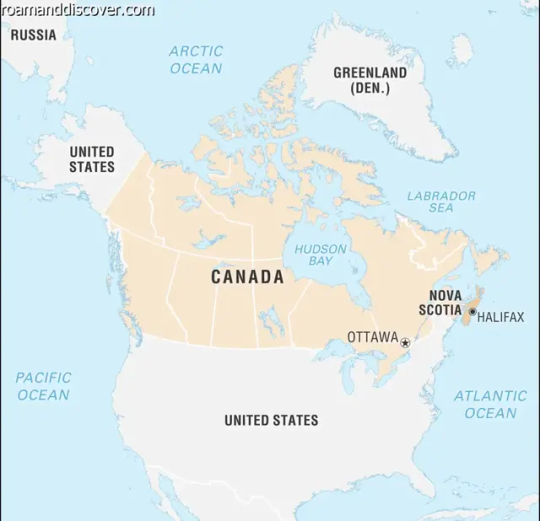
Etymology
The name "Nova Scotia" comes from the Latin term "New Scotland" and is indicative of the province's Scottish roots. It was named by Sir William Alexander, a Scotsman who received a land grant in the area in the 1600s. The province's flag, which features the Scottish flag's cross of St. Andrew and a lion rampant, also reflects this heritage.
However, the area now known as Nova Scotia has a long history of being inhabited by Indigenous peoples, including the Mi'kmaq, who called the region "Mi'kma'ki". The name "Mi'kma'ki" translates to "the land of the Mi'kmaq" and reflects the longstanding connection Indigenous peoples have had to this land.
Throughout its history, the region now known as Nova Scotia has been part of the French and British empires, with both groups leaving their mark on the area. Today, Nova Scotia is a diverse province with a rich history and vibrant culture that is influenced by the many peoples who have called it home over the years.
History
Nova Scotia has a rich and complex history that spans thousands of years. The first people to inhabits the region were the Mi'kmaq, who have lived on the land for over 10,000 years.
European colonization of Nova Scotia began in the early 1600s, with the French establishing the first permanent settlement in Port Royal in 1605. The British then arrived in the region, and over the following decades, a bitter struggle for control of the territory ensued.
The French and British engaged in several wars and skirmishes, with control of Nova Scotia frequently shifting between the two European powers. In 1713, the Treaty of Utrecht granted control of Nova Scotia to the British, but the French continued to have a significant presence in the region and even established a colony on Cape Breton Island, which remained in French hands until it was handed over to the British in 1763.
In the 18th century, Nova Scotia became a destination for Scottish and Irish immigrants, who joined the English settlers in establishing communities throughout the province. The arrival of the Loyalists in the late 1700s sparked a period of rapid growth in Nova Scotia, and the province became an important hub of commerce and trade.
In the 19th century, Nova Scotia emerged as a center of the Industrial Revolution in Canada, with coal mining and shipbuilding becoming major industries in the province. The Halifax Explosion of 1917, one of the deadliest man-made disasters in Canadian history, had a profound impact on the province and its people, both then and in the years that followed.
Throughout the 20th century, Nova Scotia experienced major economic and social changes. The province's coal mines closed, and new industries such as forestry, fishing, and tourism emerged. Nova Scotia became a center of Canada's naval forces during World War II, and many of the province's young men and women served in the military during the conflict.
Today, Nova Scotia is a vibrant and prosperous province, with a rich cultural heritage and a dynamic economy. Its history has left an indelible mark on the province, and visitors to Nova Scotia can see this legacy reflected in its architecture, its museums and galleries, and its people.
Early Settlement
The first inhabitants of what is now Nova Scotia were the Mi'kmaq people, who have lived in the region for thousands of years. They originally called their home "Mi'kma'ki". They were a semi-nomadic people who relied on hunting, fishing, and gathering for their subsistence. The Mi'kmaq people had a strong connection to the land and sea and they had a deep respect for the natural world around them.
The first European contact with the Mi'kmaq people occurred in the late 15th century when John Cabot arrived in the area. However, it wasn't until the early 1600s that Europeans began to establish settlements in the region. In 1604, the French explorer Samuel de Champlain arrived in what is now Nova Scotia and established the first European settlement at Port-Royal. The French also formed relationships with the Mi'kmaq people and engaged in trade with them.
In 1710, the British conquered Nova Scotia from the French and established their own settlements in the region. The arrival of the British led to tension and conflict with the Mi'kmaq people, who were concerned about the impact of British settlement on their way of life. Many Mi'kmaq people allied themselves with the French during the numerous wars between Britain and France in the region.
the earliest settlements in Nova Scotia were a blend of Mi'kmaq and European cultures. As Europeans established settlements in the region, they encountered and interacted with the Mi'kmaq people. Today, the Mi'kmaq people continue to live in Nova Scotia and have a strong presence in the region, both in terms of their culture and their political representation.
European Colonization
Nova Scotia has a long and complicated history of colonization by various European powers. The first Europeans to arrive in the area were the French, who established a permanent settlement at Port Royal in 1605. The English, however, were quick to claim the region for themselves, and a series of conflicts between the two powers ensued.
In 1713, the Treaty of Utrecht officially ceded Nova Scotia to Britain, and the French were forced to abandon their settlements in the region. The British immediately set about establishing their own settlements and fortifications, and over the next century, the region saw a great deal of economic and population growth.
However, the impact of colonization was not exclusively positive. The British and French both engaged in aggressive expansion and displacement of Indigenous populations, leading to significant social and cultural upheavals that continue to be felt in Nova Scotia to this day.
Furthermore, Nova Scotia was not immune to the conflicts that defined European politics in the 18th and 19th centuries. During the American Revolution, Nova Scotia became a destination for Loyalist refugees who had fled the United States, leading to an influx of new settlers and a period of rapid growth.
However, Nova Scotia's proximity to the United States meant that it was highly vulnerable to American aggression during times of war, and the region saw multiple invasions and skirmishes throughout the 19th century.
Despite these challenges, Nova Scotia continued to grow and develop throughout the 20th century, becoming an important center of industry and culture in the Atlantic region.
Today, the history of European colonization continues to be a prominent feature of Nova Scotia's social and cultural landscape, with the province's complex heritage serving as a reminder of the importance of cultural preservation and reconciliation.
Recent History
Nova Scotia has a rich history, and in recent times the province has witnessed some significant events and developments. One of the most notable of these was the 1992 closure of the Sydney Steel plant, which was a major blow to the region's economy. However, in recent years, there have been efforts to revitalize Sydney and attract new investment to the area.
In 2014, Port Hawkesbury Paper was faced with bankruptcy, but it managed to stay afloat with the help of the provincial government. This secured the jobs of many residents of the area and helped maintain the region's economy. Nova Scotia has always relied heavily on its fishing industry, but in recent years the sector has faced challenges due to overfishing and changes in the ecosystem. Despite this, there have been efforts to implement more sustainable fishing practices in the province.
In 2018, Nova Scotia made history by electing Canada's first black female Member of Parliament, a milestone for diversity and representation in the province's political sphere. the province has seen a rise in immigration in recent years, with many newcomers settling in the urban centers of Halifax and Sydney.
In terms of infrastructure, one of Nova Scotia's major developments was the opening of the Halifax Stanfield International Airport in 1960, which has since become a crucial hub for the province's transportation and tourism industries. There have also been improvements to the province's highway system, such as the completion of the twinning of Highway 103 in 2018.
More recently, the province has been investing in renewable energy, with the construction of its first tidal energy plant in 2016 and the implementation of wind farms across the province. Nova Scotia has also made strides in addressing its waste management issues, with the adoption of a province-wide ban on single-use plastic bags in 2020.
Nova Scotia has faced its fair share of challenges in recent history, but it has also demonstrated resilience and adaptability in the face of adversity. Through innovation and community-building, the province is constantly evolving and positioning itself for a bright future.
Geology
Nova Scotia's geology is characterized by a diverse range of landscapes and geological features that have been shaped by millions of years of geological processes. The province has a long and complex geological history that includes volcanic activity, glaciation, and the formation of sedimentary rocks.
One notable feature of Nova Scotia's geology is the presence of the Cape Breton Highlands, which are home to some of the oldest rock formations in Canada. These ancient rocks date back more than 500 million years and are among the oldest visible on Earth.
Another important geological feature of Nova Scotia is the Bay of Fundy, which is famous for having the highest tides in the world. These tides, which can reach more than 50 feet in height, are caused by the funneling effect of the bay's unique shape, as well as the gravitational pull of the moon and sun.
In addition to these notable features, Nova Scotia also has a diverse range of other landscapes, including rugged coastal cliffs, rolling hills, and deep valleys. The province's geological formations also include a variety of rock types, such as granite, sandstone, and shale.
Nova Scotia's geology is a fascinating and complex topic that offers insights into the province's rich natural history. Whether you're a geology enthusiast or simply interested in learning more about this unique corner of Canada, there's plenty to discover and explore in Nova Scotia.
Geography
Nova Scotia is located in eastern Canada and is made up of a peninsula and numerous islands. The province is bordered by the Atlantic Ocean to the east and the Bay of Fundy to the west. With a total area of 55,284 square kilometers, Nova Scotia is the seventh smallest province in Canada. Despite its small size, Nova Scotia has a diverse landscape that includes rugged coastlines, rolling hills, and fertile valleys.
The province is divided into six distinct regions: the Northumberland Shore, Cape Breton Island, the Annapolis Valley, the South Shore, the Eastern Shore, and Halifax. Each region has its own unique geography and physical characteristics.
The Northumberland Shore is located on the Northumberland Strait and is known for its warm waters and white sandy beaches. It is also home to a number of picturesque fishing villages and historic towns.
Cape Breton Island, located in the northeast part of the province, is known for its rugged coastline, scenic drives, and picturesque fishing villages. The island is home to the Cape Breton Highlands, a mountain range that offers breathtaking views of the Atlantic Ocean.
The Annapolis Valley is a fertile agricultural region that is known for its apple orchards, vineyards, and rolling hills. It is also home to the historic town of Annapolis Royal and the world-famous Bay of Fundy.
The South Shore is characterized by its rocky coastline, picturesque lighthouses, and charming fishing villages. It is also home to the town of Lunenburg, a UNESCO World Heritage Site.
The Eastern Shore is a remote region that is known for its rugged wilderness, unspoiled beaches, and vibrant fishing communities. It is home to the Lawrencetown Beach Provincial Park, a popular destination for surfing.
Halifax, the capital city of Nova Scotia, is located on the coast of the Atlantic Ocean. It is known for its bustling harbor, historic landmarks, and vibrant arts and culture scene.
Nova Scotia is also home to several prominent rivers, including the St. Mary’s River, the Shubenacadie River, and the Annapolis River. The province also has several major lakes, such as Bras d’Or Lake on Cape Breton Island, which is one of the largest inland sea-like bodies of water in the world.
The province’s unique geography and physical characteristics have made it a popular destination for outdoor enthusiasts. Visitors can hike the coastal trails, explore the wilderness areas, and take part in recreational activities such as sailing, kayaking, and fishing. The variety of activities and landscapes, combined with the province’s rich history and culture, make Nova Scotia a truly unique and exciting destination to visit.
Ecology
Nova Scotia is known for its diverse and stunning landscapes, which support numerous unique ecosystems and wildlife. The province's geography and climate combine to create a variety of habitats ranging from freshwater lakes and rivers to coastal tidal zones and dense forests.
One of the most distinctive ecosystems found in Nova Scotia is its Acadian Forest. This mixed woodland covers over 1.5 million hectares and is home to a range of flora and fauna. The forest is dominated by hardwoods such as sugar maple, yellow birch, and American beech, but also includes coniferous trees like eastern hemlock and red spruce. Many species of birds, mammals, and insects make their homes in the Acadian Forest, including elusive creatures like the Canadian lynx and American marten.
The province's wetlands are another vital ecosystem, playing a crucial role in filtering water, storing carbon, and providing habitat for many species. Moose, otters, and beavers are just a few of the animals that call the wetlands home.
Nova Scotia's coastline is also essential to many unique ecosystems. Rocky shorelines, sandy beaches, and tidal flats all provide habitats for a range of marine creatures. The Bay of Fundy, which stretches from New Brunswick through Nova Scotia, boasts the highest tides in the world and supports a variety of endangered species, including the North Atlantic right whale and the Atlantic salmon.
The province is also home to the Kejimkujik National Park and National Historic Site, protecting a diverse range of forest, waterways, and wildlife. The park is home to over 48 species of mammals and 206 species of birds. It's also where many rare, threatened, and endangered species, such as the Eastern wolf, American eel, and Blanding's turtle, can be found.
In addition to protecting unique ecosystems, Nova Scotia also champions sustainable practices and works to preserve its natural areas. This includes efforts to manage and maintain its forests, reduce greenhouse gas emissions, and protect endangered species.
Nova Scotia's unique geography and climate have given rise to a variety of ecosystems and wildlife. From the Acadian Forest to the Bay of Fundy and beyond, the province's natural beauty is a testament to its commitment to protecting and preserving the environment.
Biodiversity
Nova Scotia has a rich and diverse biodiversity, thanks to its varied landscapes and climates. The province encompasses forests, lakes, rivers, seacoasts, and tundra, each offering unique habitats to a wide variety of plant and animal species. To date, over 8,000 species have been identified in Nova Scotia, with more still being discovered.
The forests of Nova Scotia are home to several tree species, including the spruce, balsam fir, tamarack, and cedar. The forests also host a wealth of flora such as various mosses, lichens, and ferns. The Atlantic Ocean surrounding Nova Scotia is a vital habitat for several whale and dolphin species, including the North Atlantic right whale, humpback whales, beluga whales, and white-sided dolphins. Moreover, several species of fish, including cod, mackerel, halibut, and salmon, are an essential part of Nova Scotia's aquatic life.
Nova Scotia's wetlands, including bogs, fens, and marshes, are home to unique wildlife that has adapted to these water-rich habitats. There are several types of amphibians like frogs and salamanders, as well as reptiles such as garter snakes and green snakes who are found in these wetlands. Flocks of various waterbirds, such as herons and ducks, call Nova Scotia’s ponds and coastal marshes their home.
The province's proximity to the Gulf of Maine and the Atlantic Ocean, combined with its varied landscapes, makes it one of the best regions for bird-watching in North America. Nova Scotia’s shoreline is home to a variety of bird species such as plovers, sandpipers, and gulls. The forests offer a vast habitat for several bird species, including owls, hawks, and eagles.
In addition to the various animal species present in Nova Scotia, the province is also host to several plant species. The province has many species of wildflowers and shrubs that can be seen growing all over the place.
Read the full article
0 notes
Text
20 Indigenous firefighters in N.S. train to battle wildfires
As forest fires continue to burn throughout Canada, forcing evacuations from some First Nations communities, efforts are underway to train more Indigenous firefighters how to battle them.
This year, Natural Resources Canada provided funding in a 2 year pilot project for training programs focusing on Indigenous communities.
Last month, Nova Scotia’s Department of Natural Resources and Renewables, and the Canadian Interagency Forest Fire Center collaborated with Mi’kmaq communities throughout the province to deliver a new course on forest fire fighting.
Held at the Debert Hospitality Centre, 20 Mi’kmaw trainees spent four days learning during both in-class and hands-on field sessions.
“As a firefighter myself and an advanced care paramedic, I fully understand about the boots on the ground,” says Jennifer Jesty, the emergency resilience manager for the Union of Nova Scotia Mi’kmaq in Cape Breton.
When she heard about the course, she jumped at the chance to sign up enough participants to create an all-Indigenous class.
“Thinking about what's happened on the mainland, and that that is a real possibility to happen in Cape Breton, I thought it pretty important to see if we could finally expand the training into our Indigenous fire departments about wildland fire fighting,” she says.
Bill Stevens, a 30-year veteran volunteer member of the fire department on Eskasoni First Nation, took the course alongside his son, a fellow firefighter.
“I learned more with this training, what you've got to look for after a big forest fire,” he says.
The lesson that stuck with him the most? How to dig out hot spots after a forest fire, which often burns so hot, tree roots buried deep in the soil keep burning long after the surface flames are out.
“You have to use tools to look for burn inside the roots and inside the ground,” he explains, “you have to dig them out and make sure everything's out because there's still fire underneath.”
Scott Tingley, forest protection manager with the province’s Department of Natural Resource and Renewables, says it’s all part of efforts to train 1,000 community firefighters across the country.
“It incorporates all the safety information they need to know when they're out on that front line, (and) some the basic science about how fires behave,” he explains, “and then how to use the basic equipment and the basic techniques.”
“It’s very comprehensive,” he says.
Tingley adds the course almost didn’t happen, because of the number of wildfires in Nova Scotia earlier this year, including the devastating fires in both the Halifax and Shelburne County areas, which destroyed homes and forced thousands of people to flee.
But he says it all came together in the end, and says the participants received their certification with a “higher than average score.”
Nova Scotia is one of the first provinces to deliver the new course, which he says will not only prepare Indigenous firefighters for wildfires in their own communities, but across the country if needed.
“It improves the ability to mobilize these crews nationally and that's the whole idea of trying to increase capacity across the country,” Tingley says.
For Jesty, the course has been a key piece in making sure First Nations - like all communities - are ready for any natural disaster.
“There's no such thing as too much training,” she says.
For more Nova Scotia news visit our dedicated provincial page.
from CTV News - Atlantic https://ift.tt/HfrYLRm
0 notes
Text
2023 NHL Draft Results: Picks 101-150
101st overall, Montreal: Florian Xhekaj (Hamilton Bulldogs/Hamilton, Ontario)
102nd overall, Arizona: Terrell Goldsmith (Prince Albert Raiders/Ft. St. James, British Columbia)
103rd overall, Philadelphia: Cole Knuble (Fargo Force/Grand Rapids, Michigan)
104th overall, Washington: Patrick Thomas (Hamilton Bulldogs/Oakville, Ontario)
105th overall, Vancouver: Ty Mueller (University Of Nebraska, Omaha Mavericks/Cochrane, Alberta)
106th overall, St. Louis: Jakub Štancl (Växjö Sjöers Hockeyklubb J20/Prague, Czech Republic)
107th overall, Vancouver: Vilmer Alriksson (Djurgårdens I.F. Ishockeyförening J20/Stockholm, Sweden)
108th overall, Ottawa: Hoyt Stanley (Victoria Grizzlies/North Vancouver, British Columbia)
109th overall, Buffalo: Ethan Miedema (Kingston Frontenacs/Cobourg, Ontario)
110th overall, Montreal: Bogdan Konyushkov (Torpedo Nizhny Novgorod/Penza, Russia)
111th overall, Nashville: Joey Willis (Saginaw Spirit/Elmhurst, Illinois)
112th overall, Calgary: Jaden Lipinski (Vancouver Giants/Scottsdale, Arizona)
113th overall, New York Islanders: Jesse Nurmi (KooKoo/Kouvola, Finland)
114th overall, Columbus: Luca Pinelli (Ottawa 67's/Hamilton, Ontario)
115th overall, Tampa Bay: Jayson Shaugabay (Green Bay Gamblers/Warroad, Minnesota)
116th overall, Seattle: Andrei Loshko (Chicoutimi Saguenéens/Zhlobin, Belarus)
117th overall, Detroit: Larry Keenan II (Culver Academy Eagles/Springwater Township, Ontario)
118th overall, Los Angeles: Hampton Slukynsky (USNTDP/Warroad, Minnesota)
119th overall, Vancouver: Matthew Perkins (Youngstown Phantoms/Balgonie, Saskatchewan)
120th overall, Philadelphia: Alex Čiernik (Södertälje Sportklubb/Wolfsburg, Germany)
121st overall, Nashville: Juha Jatkola (Kalevan Pallo/Kuopio, Finland)
122nd overall, New Jersey: Cam Squires (Cape Breton Eagles/Charlottetown, Prince Edward Island)
123rd overall, San José: Luca Cagnoni (Portland Winterhawks/Burnaby, British Columbia)
124th overall, Boston: Beckett Hendrickson (USNTDP/Minnetonka, Minnesota)
125th overall, Dallas: Aram Minnetian (USNTDP/Woodcliff Lake, New Jersey)
126th overall, Carolina: Stanislav Yarovoy (H.K. Vityaz Moscow Oblast/Tuymazy, Russia)
127th overall, Florida: Albert Wikman (Färjestad Bollklubb J20/Karlstad, Sweden)
128th overall, Montreal: Quentin Miller (Quebec Remparts/Montreal, Quebec)
129th overall, Anaheim: Rodwin Dionicio (Niagara IceDogs/Herisau, Switzerland)
130th overall, San José: Axel Landén (HV71 J20/Jönköping Stad, Sweden)
131st overall, Chicago: Marcel Marcel (Gatineau Olympiques/Plzeň, Czech Republic)
132nd overall, San José: Eric Pohlkamp (Cedar Rapids RoughRiders/Brainerd, Minnesota)
133rd overall, Montreal: Sam Harris (Sioux Falls Stampede/San Diego, California)
134th overall, Arizona: Melker Thelin (Tegs Sportklubb/Umeå, Sweden)
135th overall, Philadelphia: Carter Sotheran (Portland Winterhawks/Macdonald Municipality, Manitoba)
136th overall, Washington: Cam Allen (Guelph Storm/Toronto, Ontario)
137th overall, Detroit: Jack Phelan (Sioux Falls Stampede/Downers Grove Township, Illinois)
138th overall, St. Louis: Paul Fischer (USNTDP/River Forest Township, Illinois)
139th overall, Carolina: Charles-Alex Legault (West Kelowna Warriors/Laval, Quebec)
140th overall, Ottawa: Matthew Andonovski (Kitchener Rangers/Markham, Ontario)
141st overall, Buffalo: Scott Ratzlaff (Seattle Thunderbirds/Wainwright Municipality, Alberta)
142nd overall, Pittsburgh: Mikhail Ilyin (Almaz Cherepovets/Cherepovets, Russia)
143rd overall, Nashville: Sutter Muzzatti (Rensellaer Polytechnic Institute Engineers/Alaiedon Township, Michigan)
144th overall, Montreal: Yevgeni Volokhin (Mamonty Yugry/Khanty-Mansysk, Russia)
145th overall, New York Islanders: Justin Gill (Sherbrooke Phoenix/Saint-Joseph-Du-Lac, Quebec)
146th overall, Winnipeg: Jacob Julien (London Knights/London, Ontario)
147th overall, Detroit: Kevin Bicker (Jungadler Mannheim/Schwabach, Germany)
148th overall, Seattle: Kaden Hammell (Everett Silvertips/Langley, British Columbia)
149th overall, Minnesota: Aaron Pionk (Waterloo Black Hawks/Hermantown, Minnesota)
#Sports#Hockey#Hockey Goalies#NHL#Montreal Canadiens#Canada#Ontario#Celebrities#Arizona Coyotes#Saskatchewan#British Columbia#Philadelphia Flyers#North Dakota#Michigan#Washington Capitals#Nebraska#Alberta#St. Louis Blues#Sweden#Czech Republic#Buffalo Sabres#Russia#Illinois#Calgary Flames#Arizona#New York Islanders#Finland#Columbus Blue Jackets#Tampa Bay Lightning#Wisconsin
1 note
·
View note